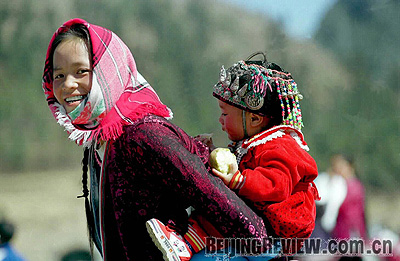| For China, the most populous country in the world, the policies that govern family planning are not taken lightly. The country has a three-decade-old population-control measure that limits many Chinese families to one child. Recently, though, scholars and policy makers have been debating whether the so-called "one-child policy" should be relaxed.
 |
|
FEWER AND HAPPIER: A mother with her kid in Guangxi Zhuang Autonomous Region. People in the region have changed their mind and would like to have fewer children than before (CHEN RUIHUA) |
"Whether a couple will give birth to one or two children is their personal choice. Individuals, couples and families should have the freedom in making the choice," said Mu Guangzong, a professor at Peking University's Institute of Population Research.
Others, however, see the policy as an effective counter to the pressures of a mounting Chinese population, which now numbers more than 1.3 billion.
"The current family-planning policy should be tightened, and a stricter one-child policy should be implemented," Cheng Enfu, an economist and President of the Marxism Research Institute, Chinese Academy of Social Sciences (CASS), told China Economic Weekly in a March interview.
Leaving the academic world and entering the political one, the National People's Congress (NPC), China's top legislature, and the Chinese People's Political Consultative Conference (CPPCC), the top political advisory body, over the past two years have discussed the country's population policy. In 2007, CASS researcher Ye Tingfang and 28 other CPPCC members advanced a proposal to nullify the one-child policy as soon as possible. Then, at the NPC session last March, economist and Renmin University of China President Ji Baocheng also suggested changing the current family-planning policy to allow each couple to have two children.
But the former Minister of the National Population and Family Planning Commission of China (NPFPC), Zhang Weiqing, said during last March's CPPCC meeting that the current birth-control policy would not be relaxed. Zhang said China will see a small birth spike in the next decade as the nearly 100 million people born in the early 1970s reach childbearing age, and that loosening the policy now would create problems for future development.
The one-child policy
Fifty years ago, the late Chairman Mao Zedong and former Peking University President Ma Yinchu, a Yale-educated economist, debated hotly over whether China should control its population.
Ma had found that China's population reached 600 million during the 1953 census. He was surprised at how fast it was growing-more than 100 million were born in the four years following the 1949 founding of the People's Republic of China. Ma predicted that if the then 2-percent population growth rate persisted, China would contain 1.5 billion people in 50 years. Ma advised the government to control the population. Mao did not heed his counsel and China soon saw a population explosion. It exceeded 1 billion in 1981, and reached 1.2 billion by 1995.
China began feeling the population pressure in the 1970s. According to Yu Xuejun, Director of NPFPC's Department of Laws and Regulations, the country's Constitution included an article encouraging family planning in 1978. The government advocated that each couple should have no more than one child. In 1982, family planning became a national policy and a couple could only bear one child, except in special cases permitted by the government.
Since the implementation of the family-planning policy, the country's population patterns have changed from high birth rate, high mortality rate and high population-growth rate to low birth rate, low mortality rate and low population-growth rate, Yu said.
Official statistics show that women's total fertility rate, the number of children a woman is expected to have in her lifetime, dropped from 5.8 before the adoption of the one-child policy to a current rate of about 1.8. Those numbers equate to more than 300 million fewer people being born over the past three decades, said Renmin University President Ji, and the slowing growth has alleviated the pressure on resources and the environment.
Heavy population burden
Even though the one-child policy has significantly lowered China's fertility rate, the population grows by 8 million to 10 million people every year because of the large number of people already living in the country, according to official statistics.
| 